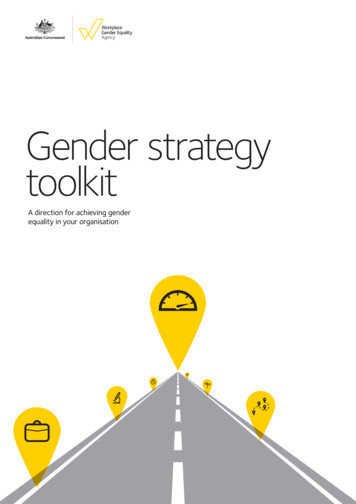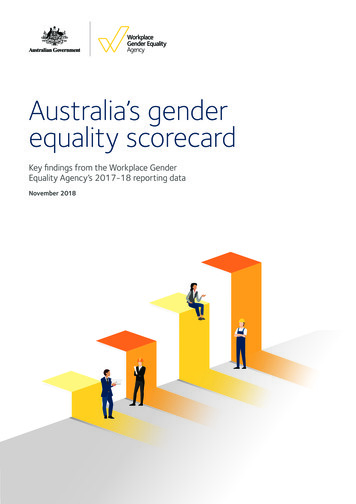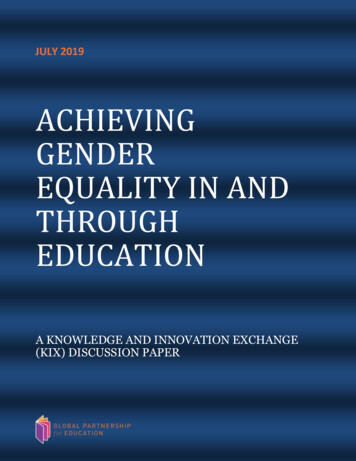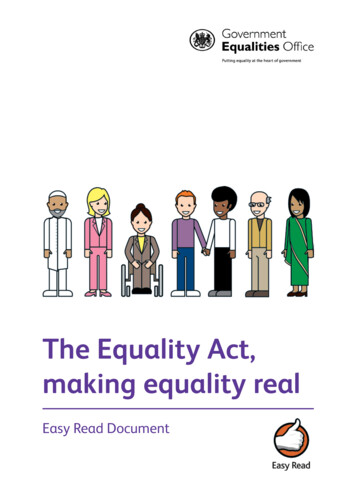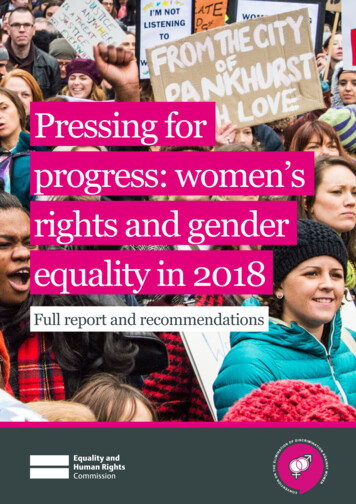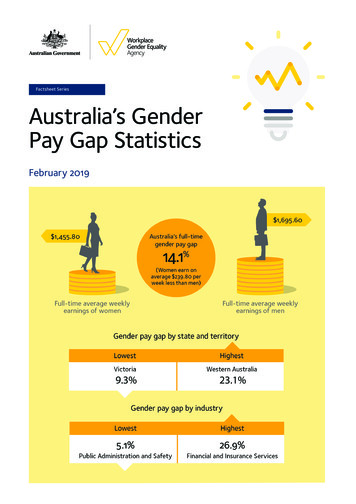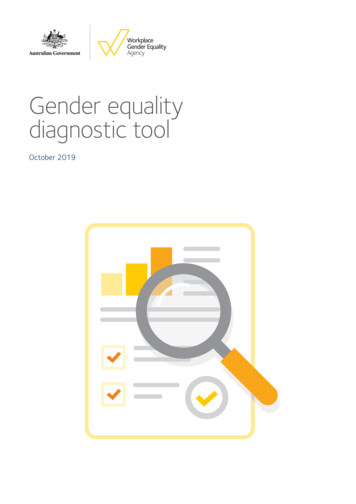
Transcription
Gender equalitydiagnostic toolOctober 2019
ContentsIntroduction . 1The gender equality focus areas. 2Scoring each gender equality focus area. 3The 17 gender equality focus areas. 4Strategic alignment of gender equality and business priorities . 5Leadership and accountability.6-73 Gender pay equity.8-94 Gender composition of the workforce.105 Support for caring.11-126 Mainstreaming flexible working. 137 Preventing gender-based harassment and discrimination,sexual harassment and bullying. 14-158 Support for employees experiencing domestic and family violence. 16-179 Professional development, networking, mentoring, sponsorship.18-1910 Applying a gender lens to all policies and strategies.2011 Recruitment, selection and promotion.2112 Talent management and succession planning.2213 Workplace gender equality training.2314 Applying a gender equality lens to everyday operations.2415 Applying a gender equality lens to casual, contract,independent contract and short-term, task-based employment.2516 Driving change beyond the workplace.2617 Applying a gender equality lens to mergers, acquisitionsand restructures.2712Overall Scorecard.28Analysis of results.29Appendix A2.30www.wgea.gov.auWorkplace Gender Equality Agency
IntroductionThe Workplace Gender Equality Agency’s (‘WGEA’ or ‘Agency’) Gender EqualityDiagnostic Tool (Diagnostic Tool) helps you to analyse the status of genderequality and pinpoint gender equality gaps within your organisation. It can beused with the Gender Equality Strategy Guide (the Guide) to assist with thedevelopment of a strategy for addressing inequalities. You can use this tool beforeyou develop your overarching strategy or as part of a regular review process.The diagnostic process involves answering‘yes’/’no’ questions in 17 gender equality focusareas and accumulating an overall score whichindicates where your organisation falls between‘meeting minimum requirements’ and ‘leadingpractice’ in addressing gender equality.Do not feel overwhelmed if you cannot initiallyanswer ‘yes’ to all of the questions in eachgender equality focus area. Draw on your resultsto identify an appropriate number of areas toprioritise for action.Your gender equality strategy and theaccompanying goals and objectives will evolveover time, so no matter where your organisationis in the process, you can periodically return tothis diagnostic tool to review your progress.To begin, look at the questions and record yourscore for each into the table for the relevantgender equality focus area. Tally your score anduse the scorecard (at the end of this document) toget an understanding of how far along the processyou are.Use your results to build a genderequality strategyWe suggest you use the companion Guide tohelp you develop a gender equality strategy thatis relevant to your organisation. You can use theresults from this Diagnostic Tool to help informyour gender equality strategy.Every organisation and industry has its uniquechallenges when it comes to gender equality.At times, you may need to use your judgement toadapt this tool to suit your specific circumstances.www.wgea.gov.auWorkplace Gender Equality AgencyHere are some suggested steps to take1. Begin by using the scoring process in thisDiagnostic Tool to identify gender equalityfocus areas to prioritise. These may beareas that are relevant to your organisationwhich have a lower total score (indicatingthat there is still plenty of work to do). Useyour judgement to determine where youshould focus your actions.2. Use the scoring outcomes as a checklistand focus on developing goals andobjectives in the areas where you wouldlike to make improvements.3. When you feel it is practical andappropriate, move on to other genderequality focus areas. There is no timeframefor this process.4. Use the questions, the data you collected,as well as the linked resources to help youto design goals and objectives.If your organisation has already made a lot ofprogress towards gender equality you mightuse the gender equality strategy guide and thisDiagnostic Tool to track your progress and identifynew areas to address.If you have answered ‘yes’ to many questionsacross the spectrum of gender equality focusareas, you may wish to consider applying forWGEA’s Employer of Choice for Gender EqualityCitation program (EOCGE). The EOCGE citationis a leading practice recognition program thataims to encourage, recognise and promote activecommitment to achieving gender equality inAustralian workplaces. You can find informationabout incorporating EOCGE citation standards intoyour gender equality strategy inAppendix A of this document.1
The gender equalityfocus areasGender Equality Focus Areas21Strategic alignment of gender equality and business priorities2Leadership and accountability3Gender pay equity4Gender composition of the workforce5Support for caring6Mainstreaming flexible working7Preventing gender-based harassment and discrimination, sexual harassment and bullying8Support for employees experiencing domestic and family violence9Professional development, networking, mentoring, sponsorship10Applying a gender lens to all policies and strategies11Recruitment, selection and promotion12Talent management and succession planning13Workplace gender equality training14Applying a gender equality lens to everyday operations15Applying a gender equality lens to casual, contract and short-term, task-based employment16Driving change beyond the workplace17Applying a gender equality lens to mergers, acquisitions and restructureswww.wgea.gov.auWorkplace Gender Equality Agency
Scoring each gender equalityfocus areaUse this scorecard to get a sense of how your organisationis progressing against each focus area.To use the scorecard, fill out the rubric against each gender equality focus area and then tally up yourpoints. Compare your total score for the focus area to the ‘Gender Equality Focus Area Score’ column inthe scorecard below and find out where you are.In order to score your organisation you will need to gather evidence so that you can make informeddecisions. This Diagnostic Tool includes a ‘Suggested Data Source’ section for each focus area. This sectiondoes not contain a comprehensive list of sources, but can be used as a guide to help you get started.Once you have tallied your score in a gender equality focus area, there is a section called ‘Moving theAgenda Forward ’, which has suggestions for what to think about next if you intend to take action. There isalso a ‘Resources’ section with links to relevant sources of information for each focus area.GENDER EQUALITY FOCUSAREA SCOREWHERE YOU AREMEETING MINIMUM REQUIREMENTS – it is important to beMostly 'yes' in A questionscompliant with Agency reporting, however moving beyond minimumrequirements will help deliver positive change for employees andthe organisation.ACTIVE – at this level employing a strategic approach will helpMostly ‘yes’in A and B questionsMostly ‘yes’in A, B and C questionsturn ideas into actions. Clearly communicating your commitmentto promoting gender equality will help gain employee supportand prepare for the change process.STRATEGIC – you have successfully created an organisation-widealignment between gender equality and business priorities.LEADING PRACTICE – you have comprehensively addressed genderMostly ‘yes’in all the questionswww.wgea.gov.auequality within your organisation, from compliance to an integratedand strategic approach. There is always more to do. The next stepmight involve reaching out through your networks, partners and evenyour customers to share your practice and help them to improve ifthey need to.Workplace Gender Equality Agency3
The 17 GenderEquality Focus Areas4www.wgea.gov.auWorkplace Gender Equality Agency
Focus Area 1Strategic alignment of gender equality andbusiness priorities!PolicyThe guidelines, rules and proceduresan organisation develops to govern itsactions and outline decision-making dosand don’ts. It is widely communicated andaccessible by all staff.It is critical that the development of your organisation-wide gender equality strategysupports and aligns with your overall business strategy. Each organisation’s genderequality strategy needs to be tailored to each businesses’ needs, based on customerfocus, market position, operational strategy, geography and industry dynamics.StrategyAn action plan an organisation creates toachieve one or more goals and bridge thegap between where it is and where it wantsto be. It relates to how you allocate and usematerials and human resources and requiresan executive decision.Suggested data sources your organisation’s business strategy and business plansyour organisation’s strategic targets and performance measuresindustry benchmarks and WGEA Competitor Analysis Benchmark Reports.SCOREADoes your organisation have a current gender equality policy?BDoes your organisation have a current gender equality strategy?BDoes your organisation hold regular gender equality events to profile yourpolicy or strategy and planning process?CIs your gender equality strategy incorporated into your broaderbusiness strategy?CDoes your gender equality strategy have a dedicated budget?DDoes your organisation conduct regular monitoring and evaluation ofyour gender equality strategy?DDoes your organisation report publicly on its performance against itstime-specific gender equality objectives?NO 0 pointsYES for A 1 point eachYES for B 2 points eachYES for C 3 points eachYES for D 4 points eachTOTAL SCORE0Moving the agenda forward What are the key strategic objectives and priorities for your organisation?How can gender equality support your strategic objectives?Are your key strategic initiatives aligned with the development of your gender strategy?ResourcesWomen in Leadership – Lessons from Australian Companies Leading the Way(WGEA, McKinsey & Company and Business Council Australia (BCA)) Strategy Matters: Evaluating Company Approaches for Creating Inclusive Workplaces (Catalyst) The Business Case for Gender Equality (WGEA) www.wgea.gov.auWorkplace Gender Equality Agency5
Focus Area 2Leadership and accountabilityCommitment by leaders at all levels is the key to gender equality in every organisation. For the purposes ofthis tool, we will not be prescriptive about the definition of leadership. You will need to use your judgementto determine who the leaders in your organisation are. To progress gender equality, leaders need to be activeadvocates and role models for gender equality. Leaders are encouraged to consider that “What we say; howwe act; what we prioritise; and how we measure; together, determines what gets done.”1 Leaders need to setclear expectations that others can follow.Suggested data sources e ngagement survey or focus group data on culture, inclusion and/or diversity with respectto all levels of leadershipleaders’ achievements against gender targets and business scorecardsevidence of visibility of the CEO/head of business as a champion of gender equality, internallyand externally.SCOREIs the responsibility for your gender equality work spread across all levelsof leadership?NO 0 pointsBDo your leaders demonstrate commitment to gender equality on a regular basis?YES for B 2 points eachBAre individual managers or leaders given accountability for discrete genderequality projects or initiatives?CIs formal accountability for gender equality progress and outcomes defined andis accountability held by managers at all levels?DIs maintaining gender equality seen as everyone’s responsibility, while leadersand managers are routinely accountable, evaluated and rewarded for results?DAre there material consequences for leaders or managers who breachexisting gender equality policies or who demonstrate unacceptable behaviours,including when their staff fail to meet these standards?AYES for A 1 point eachYES for C 3 points eachYES for D 4 points eachTOTAL SCORE01 Chief Executive Women & Male Champions of Change 2014, It Starts With Us: The Leadership Shadow, viewed 4th of July 2019,available: /document/publication/MCC-LeadershipShadow 210314.pdf6www.wgea.gov.auWorkplace Gender Equality Agency
Moving the agenda forwardRecent signs of your leaders’ commitment to gender equality, for example: a written or verbal statement to all employees and/or externally outlining their commitment togender equalityengaging with clients about inclusive work practicesrole modelling part-time or other flexible working.Whether your organisation prioritises gender equality, for example: your CEO is a WGEA Pay Equity Ambassadoryour organisation is a WGEA Employer of Choice for Gender Equality citation holder, or workingtowards becoming onethere is senior involvement in a formal diversity or gender equality committee that overseesthe gender strategy and outcomesleaders receive specific training and coaching on gender equality.ResourcesBacklash and Buy-In: Responding to the Challenges in Achieving Gender Equality(Male Champions of Change, Chief Executive Women) It Starts With Us: The Leadership Shadow (Male Champions of Change, Chief Executive Women) Boards for Balance: Your Leadership Shadow – Partnering with Your CEO for Gender Balance(Chief Executive Women, AICD) www.wgea.gov.auWorkplace Gender Equality Agency7
Focus Area 3Gender pay equityGender pay equity is when women and men performing work of equal or comparable value are paidthe same.Employers must make sure they are compliant with all pay equity obligations under the Fair Work Act 2009and the Workplace Gender Equality Act 2012 and relevant state, territory and federal anti-discrimination laws.Addressing pay equity in your organisation will foremost involve correcting any instances of pay inequalitywhen it comes to two people doing work of equal or comparable value. This is commonly referred to as a 'likefor-like gender pay gap. Instances of like-for-like gender pay inequality are unlawful and must be addressedimmediately when identified.Action on pay equity may also involve analysing and monitoring your organisation-wide gender pay gap: thedifference between the average remuneration of women and the average remuneration of men across thewhole organisation (or department).It is also important that terms and conditions of employment contracts are considered when taking actionon gender pay equity. Gender biased terms and conditions can result in unequal allocation of roles andremuneration.Suggested data sources 8your WGEA Competitor Analysis Benchmark Reports showing gender pay gap comparisonsdata on any instances of gender pay inequality in your organisationdata on remuneration by gender and by job.www.wgea.gov.auWorkplace Gender Equality Agency
SCOREADoes your organisation have a formal remuneration policy, with guidelinesfor remuneration with specific gender pay equity objectives?BHas your organisation conducted an organisation-wide gender pay gap analysis?BHas your organisation conducted an organisation-wide gender pay equityanalysis to determine whether women and men doing the same work, ordifferent work of equal or comparable value, are paid the same amount?BHas your organisation corrected all instances of gender pay inequality? (i.e. 'likefor-like' gender pay gaps)CDoes your organisation conduct an organisation wide gender pay gap analysisat least annually?CDoes your organisation include salary ranges in job advertisements?CDoes your organisation measure the starting graduate pay gap?CHas your organisation conducted a gender-neutral job review/evaluation inaccordance with the Australian Standards for Gender-Inclusive Job Evaluationand Grading?CHas your organisation taken action to minimise the impacts of negotiationon pay setting?DDoes your organisation set targets to reduce any organisation-wide gaps?DDoes your organisation report pay equity metrics to the governing body, theexecutive, all employees and externally?DDoes your organisation make superannuation contributions to workerson paid and unpaid periods of parental leave?NO 0 pointsYES for A 1 point eachTOTAL SCOREYES for B 2 points eachYES for C 3 points eachYES for D 4 points each0Moving the agenda forwardThink about: policies in relation to gender pay equity, including remuneration policy, pay scales and/or salarybands, enterprise agreements, bonus and incentive structures and reporting against any existingpay equity targets recent signs of your leaders’ commitment to gender pay equity transparency of salary bands and gender pay equity gaps potentially gendered nature of remuneration (discretionary pay, allowances, payment of overtimeand graduate entry remuneration)are all staff, including women, on the correct award classification scale/level in accordance with their skills/experience? Resources Closing the Gender Pay Gap (Male Champions of Change)The Economics of the Gender Pay Gap (Diversity Council Australia, KPMG & WGEA)Addressing Pay Equity (WGEA) Gender and Negotiation in the Workplace (WGEA)Guide to Australian Standard on Gender-Inclusive Job Evaluation (WGEA)Gender pay equity best practice guide (Fair Work Ombudsman)www.wgea.gov.auWorkplace Gender Equality Agency9
Focus Area 4Gender composition of the workforceGender-balanced organisations tend to have greater employee engagement and retention. They also havethe potential to perform better than organisations that are dominated by one gender. Research shows thatgender balance at leadership, executive and board levels is important, because it can improve the quality ofstrategic decision-making and innovation2.Suggested data sources gender composition of board, executive, senior managers, managers, total workforce(by business units / team / location )gender composition of employees joining the organisation (by business units / team / location )gender composition of employees leaving the organisation and reason given for leaving(by business units / team / location).SCOREADoes your organisation collect and analyse data on gender composition innon-management, management and the governing board?BDoes your organisation track and analyse the reasons for resignationby gender?BDoes your organisation have one or more programs addressing genderimbalances, for example: promoting women to leadership or gender balancein career-advancing opportunities (e.g. learning and development)?CDoes your organisation evaluate and analyse staff movements (promotionsand appointments) by gender?DDoes your organisation have gender balance targets with achievabletime frames?DAre gender equality, gender composition and retention objectives part ofmanagers’ performance objectives?NO 0 pointsYES for A 1 point eachYES for B 2 points eachYES for C 3 points eachYES for D 4 points eachTOTAL SCORE0Moving the agenda forward What are the reasons for gender imbalances? For example, location, hours of work, health and safetyissues – why are women or men not applying for specific roles?Why do people join or leave your organisation?What methods do you use to recruit for gender balance within the organisation, on boards orgoverning bodies connected with your organisation?Resources 2Setting Gender Targets (WGEA)Gender Equitable Recruitment and Promotion: A guide for Organisations (WGEA) BCEC 2017, Gender Equity Insights 2017: Inside Australia’s Gender Pay Gap, viewed 04 June 2019, 20Insights%202017%20Report.pdf WGEA 2018, The Business Case for Gender Equality, viewed 04 June 2019, ty 0.pdf10www.wgea.gov.auWorkplace Gender Equality Agency
Focus Area 5Support for caringThis focus area relates to support for employees with caring responsibilities, including caring for children, elderlypeople, or dependents living with a disability. Caring commitments are increasingly common within diverseworkplaces. Career breaks associated with taking time off to engage in caring contribute to gender inequalities inthe workplace. Policies and practices that support caring help to attract and retain top talent.All organisations must ensure that they are compliant with the relevant state, territory and federal antidiscrimination legislation that protects the rights of carers and the people they care for. The Fair Work Act 2009also provides for certain employees to request flexible working arrangements in certain circumstances. Publicservice agencies and associated providers must also take practicable measures to pay due regard to the statementsenshrined in the Carer Recognition Act 2010 (Cth).Suggested data sources the number and location of parent rooms and breastfeeding facilitiesuptake of support services such as on-site childcare, school holiday caring arrangements, coachingfor employees returning from long-term leave and flexible working arrangements.Data on employees by gender accessing technologies to enable flexible work utilisation of parental leave by women and men promotions during pregnancy, parental leave and during long-term leave periods employees returning from parental leave and other forms of long-term leave exits (including dismissals and redundancies) when pregnant and during and after periods oflong-term leave exits (including dismissals and redundancies) within 12 months of return from parental leave. SCOREADoes your organisation fulfil the legal requirements relevant to family andcaring support?BDoes your organisation have provisions to support caring, for example,breastfeeding facilities or advice on carers’ support services?BDoes your organisation have a keep-in-touch program for employeeson carers leave and/or on-boarding support for workers returning from longterm leave?CDoes your organisation offer employer-funded paid parental leave?CDoes your organisation have a variety of non-leave based measures to supportcarers, including holiday care support services, childcare referral service,emergency care referral service (children, elder and care for people living with adisability)?DDoes your organisation offer all employees parental leave and superannuationpayments on paid and unpaid leave?DDoes your organisation have a personal development program in place forparents (both female and male), including coaching for parents returning towork from parental leave and parenting workshops?TOTAL SCOREwww.wgea.gov.auWorkplace Gender Equality AgencyNO 0 pointsYES for A 1 point eachYES for B 2 points eachYES for C 3 points eachYES for D 4 points each011
Focus Area 5 continuedSupport for caring continuedMoving the agenda forwardThink about: The ways your organisation could support female and male employees who are carers (parenting,elder care, care for people living with a disability). This might include flexible work (policy, technologyand culture), parental leave, paid superannuation during long-term leave, keep-in-touch initiativesduring long-term leave and assistance preparing for return from leave.The ways your organisation could support managers to implement the organisation’s policies andprocedures which support employees with caring responsibilities. This might include communicatingthe organisation’s policies and procedures to managers to raise awareness of these and providingtraining to managers on how they can encourage and facilitate staff access to organisational policies. Resources 12Investing in Care Recognising and Valuing Those Who Care(Australian Human Rights Commission)Supporting Working Parents: Pregnancy and Return to Work National Review(Australian Human Rights Commission)Developing a Leading Practice Parental Leave Policy (WGEA)Policy statement: Male Carers (Carers NSW)Policy statement: Female Carers (Carers NSW)Supporting carers in the workplace: A Toolkit (Australian Human Rights Commission)Workplace Flexibility online learning course (Fair Work Ombudsman)Requests for Flexible Working Arrangements Fact Sheet (Fair Work Ombudsman)Work and Family Best Practice Guide (Fair Work Ombudsman)Parental Leave Best Practice Guide (Fair Work Ombudsman)Balancing Work and Family Templates (Fair Work Ombudsman)www.wgea.gov.auWorkplace Gender Equality Agency
Focus Area 6Mainstreaming flexible workingEquitable access to flexible ways of working enhances talent attraction and retention, employee engagementand productivity. Flexible work enables individual employees to balance the needs of work and home. Flexibleworking arrangements come in a variety of shapes and forms and extend beyond part-time work and remoteworking. Flexible working has successfully been implemented in a broad range of workplaces, it is not just foroffice workers.Suggested data sources uptake of flexible working by genderunplanned absence or leave records for flexible workersperformance ratings, promotion rates and engagement scores for flexible workers.SCOREADoes your organisation have a flexible working policy and/or strategy?BDoes your organisation offer manager training to enable flexible working?BIs technology, or rostering systems, available to support flexible working? (e.g.home based work, flexible working etc.)CDoes your organisation survey employees to identify their perspective onhaving access to the flexibility they need?CDo female and male leaders (including line managers) visibly role model flexibleworking at your organisation?DHave targets been set for engagement in flexible work for both womenand men?DDoes your organisation's implementation of flexibility focus onacknowledgement that outputs and results are valued rather than visibility at aparticular time or place?TOTAL SCORENO 0 pointsYES for A 1 point eachYES for B 2 points eachYES for C 3 points eachYES for D 4 points each0Moving the agenda forward How does your organisation promote and normalise flexible working for all employees, in all roles,for any reason?How do your leaders model flexible ways of working?What incentives, targets and measures do you have in place?Resources The Business Case for Flexibility (WGEA)The Power of Flexibility: A Key Enabler to Boost Gender Parity and Employee Engagement(Chief Executive Women, Bain and Company)Future-Flex: Mainstreaming Flexibility by Design (Diversity Council Australia)Strategic Approach to Flexibility (WGEA)Does this Desk Make my Job Look Big? (Troy Roderick, The University of Sydney)Requests for Flexible Working Arrangements Fact Sheet (Fair Work Ombudsman)Workplace Flexibility Online Learning Course (Fair Work Ombudsman)Balancing Work and Family Templates (Fair Work Ombudsman)www.wgea.gov.auWorkplace Gender Equality Agency13
Focus Area 7 reventing gender-based harassment andPdiscrimination, sexual harassment and bullyingGender-based harassment and discrimination, sexual harassment and bullying inthe workplace have significant negative impacts on people and organisations. Itcan reduce employee well-being, job satisfaction, commitment and productivity,increase absenteeism and employee turnover and negatively affect workplaceculture. Employers can also be held legally responsible for acts of sexualharassment committed by their employees or agents.Not only do these factors lead to increased costs for people and organisations,they also have a significant gendered impact on employee engagement, thetypes of industries that are appealing to different genders and employees’promotional opportunities.The way an organisation educates workers on their rights and obligationsregarding gender-based harassment and discrimination, sexual harassment andbullying is important. The aim is to eliminate harassment, discrimination andbullying in the workplace and promote an inclusive culture through behavioursreinforced by education and training (including bystander awareness training).!It is important that yourorganisation has an appropriatecomplaints process in place forgender-based harassment anddiscrimination, sexual harassment andbullying. Your organisation must havemanagers and HR professionalswith the skills to appropriately respond toco
Leadership and accountability Commitment by leaders at all levels is the key to gender equality in every organisation. For the purposes of this tool, we will not be prescriptive about the definition of leadership. You will need to use your judgement to determine who the leaders in your organisation are.
